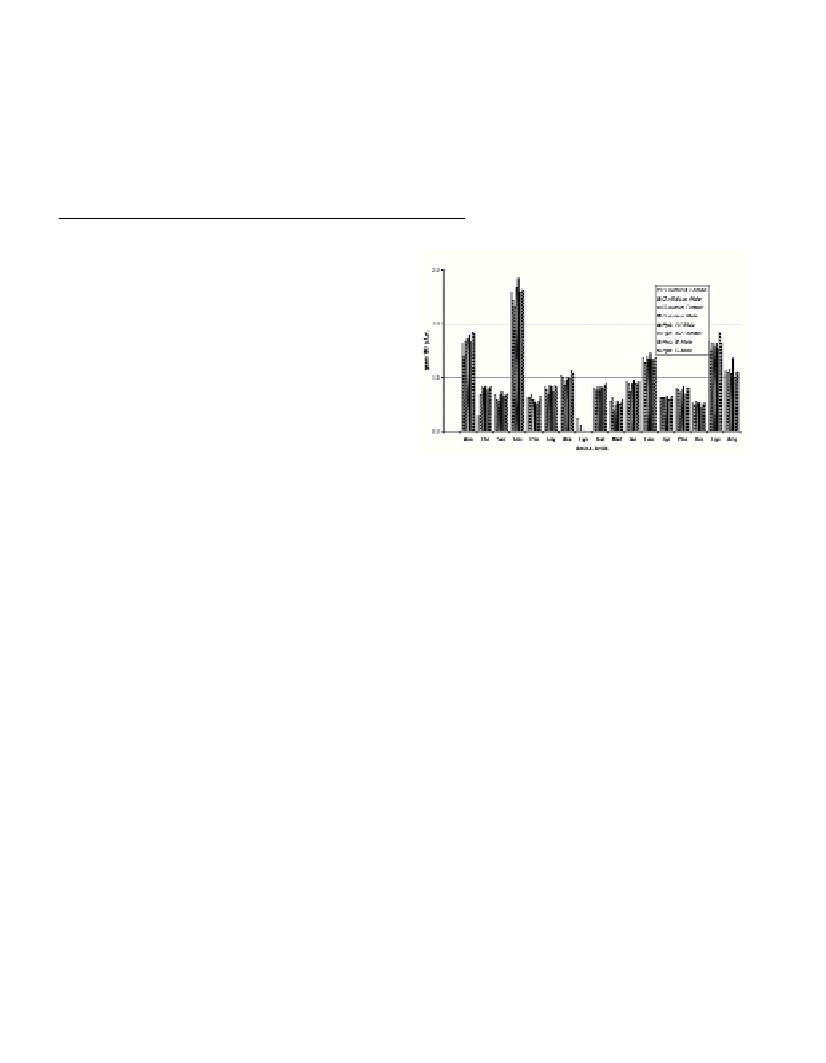AMINO ACIDS’PROFILE OF OREOCHROMIS SPECIES IDENTIFICATION IN MEDITERRANEAN LAKES -
A SUGGESTED MARKER FOR AQUACULTURE PURPOSES
Magda I. Zaki and Samir G. Ghabrial *
National Institute of Oceanography and Fisheries (NIOF), Kayed Bay, Alexandria, Egypt - * esamgabriel1@hotmail.com
Abstract
Two Oreochromis specieswere collected from Mediterranean lakes near Alexandria according to their morphological characteristics.
Those which were known to belong to the pure strain were induced for spawning in order to obtain the pure offspring and the resulting
hybrid. The protein content and amino acid profile were studied. The suspected wild species was found to be a hybrid. Thus advice must
be taken into consideration when choosing the brood stocks in aquaculture practices.
Keywords : Freshwater fish / protein content/ amino acid / identification / hybrid
Rapp. Comm. int. Mer Médit., 37,2004
559
Introduction
Species identification is an important issue when choosing fish for
culture activities. The offspring will be similar to the parental brood-
ers in a way or another. Amino acid’s analysis is used in the present
study to differentiate the pure strains from the hybrid. The experimen-
tal hybrids are also needed to be compared with those of the wild.
Materials and Methods
Two species of Oreochromis were investigated: Oreochromis niloti-
cusand Oreochromis aureus. The samples were collected from three
sites; two Mediterranean lakes near Alexandria and one Nile estuary
as a control.
The main taxonomic criteria for species identification were deter-
mined morphologically.
Spawning of the pure parental species was induced by manipulat-
ing the environmental conditions. The hybrid was achieved by cross-
ing male O. niloticuswith female O. aureusto produce male and
female hybrids (A1&A2) respectively while crossing male O.aureus
with female O.niloticusproduced the male hybrid (B).
The total protein of the white muscle in the pure strain and the
resulting hybrid was determined using the microkeldahl method (1)
and amino acid extracts were prepared (2) then injected in instrument
capsule of Beckman 116 GI amino acid analyzer apparatus. Suspected
hybrids (C) from the former wild locations were also investigated. All
fish were reared under the same condition.
Results and Discussion
The majority of both selected pure strains had the same character-
istics described at the beginning of the last century (3) and assured
later (4) deviating little than Avault (5).
The present study demonstrated large differences in the concentra-
tion of protein content and amino acid profile from one species to
another and from one sex to another. The highest crude protein con-
tent (15.31%) was found in male hybrid B followed by female O.
niloticus(14.85%) while hybrid A1 showed the third ranking order in
its crude protein.
Male hybrid A1 had the highest total aminoacid content over all
pure species and hybrids (17.474 g/100 g fresh weight) followed by
male hybrid B (17.106 g/100 gfw). The suspected wild male hybrid C,
collected from lake Edku, had 17.085 g./100gfw; quite close to the
experimentally resulting hybrids but still significant. The lowest val-
ues of total aminoacid content belonged to male O. niloticus, female
O. aureusand female hybrid A2. Gunasekera et al.(6) found a signif-
icant difference in the free aminoacid content of two groups of
Oreochromis niloticuslarvae – their mothers were originally fed on
10.2 and 35% crude protein – but not in the total protein content val-
ues.
Concerning the aminoacid’s profile (Fig. 1), Glutamic acid,
Aspartic acid and Lysine were shown to be the highest aminoacids in
the muscles of Oreochromis species and their hybrids while systine
was the lowest aminoacid. Eight aminoacids possessed the highest
values in the resulting male hybrid A 1over all other species and sexes.
Four aminoacids had the highest values in male hybrid B. The sus-
pected natural male hybrid C had both Valine and Tyrosine as the
highest values over all other species and sexes. This reveals the signif-
icant differences in the aminoacids quality and composition of the
species under consideration and its hybrid although other species (7)
had no significant differences in their aminoacid composition when
expressed as g/100g aminoacids and suggested that the aminoacid
requirements of ?atfish may not be greatly different among species.
The problem of species identification for aquaculture practices is
further complicated with the presence of hybrids which are usually
intermediate in appearance to both parental species and biased to the
maternal gamete (8,9) .
References
1-Association of Official Agricultural Chemists,1980. Official methods
of analysis. AOAC , Washington D.C., USA.
2-Moore, S., Speckman, D.H. and Stein, W.H., 1958. Chromatography of
amino acids on sulphonated polysterine resins. Anal. Chem.: 1185-1187.
3-Boulenger F.R.S., 1907. Zoology of Egypt. The fishes of the Nile. Pub.
Hugh Rees Limited, London, 577 p.
4-Trewavas, E., 1983.Tilapiine fishes of the Genera Sarotherodon,
Oreochromisand Danakilia (1983). Trustees of the British Museum
(Natural History), Publication Number 878, 583 p.
5-Avault, J.W., 1970. Miristic, morphometric and physiological
comparisons of T.aurea(Trewavas), T. mossambicus(Peters) and their
experimentally produced hybrids. Presented at annual meeting of the
Louisiana Academy of Sciences, 9 p.
6-Gunasekera , R.M., Shim, K.F., Lam, T.J., 1996. In?uence of protein
content of broodstock diets on larval quality and performance in Nile
tilapia, Oreochromis niloticus(L.). Aquaculture, 146(3-4): 245-259.
7-Lall, S.P., Dae Kim, Jeong, 2000. Amino acid composition of whole
body tissue of Atlantic halibut (Hippoglossus hippoglossus), yellowtail
?ounder (Pleuronectes ferruginea) and Japanese ?ounder (Paralichthys
olivaceus). Aquaculture,187(3-4): 367-373.
8-McAndrew, B.J., Majumdar, K.C.1983. Tilapia stock identification
using electrophoretic markers. Aquaculture, 30: 249-261.
9-Ghabriel, S.G., 1990. Induced spawning and developmental criteria of
two Oreochromis speciesand their hybrid. M.Sc. Thesis, Fac.of Science,
Alexandria Univ., 101 p.
Fig.1: Amino acid’s content in the muscles of the pure strains of
Oreochromis species and the resulting hybrids. Asn. = Aspartic acid, Thr.
=Threonine, Ser. =Serine, Glu. = Glutamine, Pro. =Proline , Gly. =Glycine,
Ala. =Alanine , Cys. Cysteine, Val.= Valine, Met. =Metionine, Iso.
=Isoleucine, Leu. =Leucine, Tyr. =Tyrosine, Phe. = Phenylealanine, His. =
Histidine, Lys. = Lysine & Arg. = Arginine.

